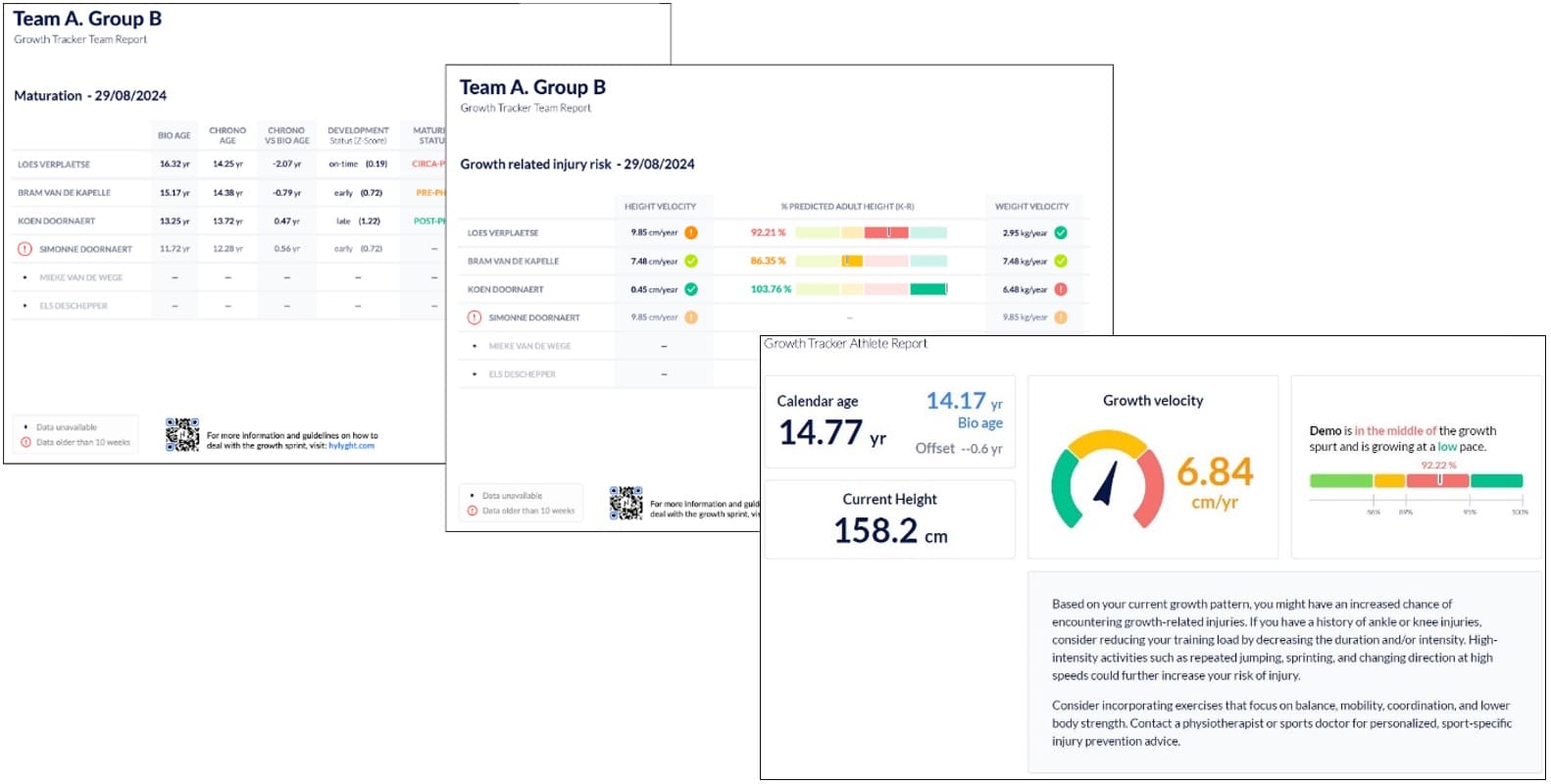The Growth Tracker explained in five minutes
 Show all articles on the knowledge base with the filter:
Tracking Growth
Show all articles on the knowledge base with the filter:
Tracking Growth
Reading Time: +/- 5 mins
Table of Contents:
1. What is the Hylyght Growth Tracker?
Between 10 and 16 years old, athletes go through puberty, which is accompanied by a growth spurt. However, the timing of this growth spurt can differ significantly from person to person. Therefore, within the same youth team there could be early mature athletes who already reached their adult height, and athletes of the same age who are late mature and are only at the start of their growth spurt. Although these youth athletes are in the same team, they have very different physical capabilities and training needs. The Hylyght Growth Tracker is a practical tool to efficiently monitor the growth velocity and maturity status of youth athletes.
2. Why monitoring growth velocity and maturity status is important
Monitoring the growth velocity and maturity status of youth athletes is crucial to:
- create maturity appropriate training environments
- reduce injury burden of growth related injuries
- take into account the effects of maturation when in talent detection.
Create maturity appropriate training environments
Early maturing athletes tend to rely on their physical dominance, as they are stronger and faster while disregarding technical and tactical skills. Late maturing athletes experience less success and might even drop out because of this. To restore competitive equity, groups could be bio-banded by grouping athletes according to their biological age (maturity), instead of their chronological age. Bio-banded groups should not replace the existing age categories, but experiments with complementary bio-banded trainings and tournaments have shown to have a positive effect on the development and learning experiences of both early and late maturing athletes.
Reduce injury burden
Around the age of the growth spurt, athletes often start to train more intensively. Unfortunately, this is also the period in which youth athletes are more prone to injuries. This has led to an increased prevalence of in injuries during the period of peak height velocity. When growth velocity and maturity status are monitored, the athletes with highest risk for growth related injuries can be offered alternative training programs to reduce the training load. This can be achieved by:
- Reducing repetitive intensive activities such as sprinting and jumping
- Giving more attention to technical and tactical aspects
- Focusing on balance, mobility, coordination, and core stability
- Reducing load by training on cushioned surfaces
Talent detection
Early maturing athletes, being taller, stronger, and faster than their peers, usually perform better in competitions and are overrepresented in talent selections. Due to this selection bias, youth academies run the risk of investing in averagely talented early maturing athletes - at the cost of more talented late maturing athletes. Using the Growth Tracker, the maturity status of youth athletes can be taken into account when making judgements about the skill level compared to peers. Furthermore, an estimation of adult height could help with guiding athletes to an appropriate sport or position within their sport.
3. How Hylyght facilitates monitoring growth and maturity
Hylyght helps experts in 3 crucial steps to work in a science-based and data-driven way:
- Measure your athletes correctly
- Assess the results according to the newest scientific standards
- Guide your athletes using clear individual and team reports
Measure
We suggest measuring the stature of youth athletes every 2 or 3 months. To gather data more efficiently we developed the Hylyght test app. Using this tool you can save data directly into the online platform from any device. Alternatively, by connecting the Seca286 to the Hylyght platform data collection can be automated.
Assess
On the results page of the Hylyght platform the most important variables for the monitoring of growth and maturity in youth athletes are automatically calculated. The platform allows to sort athletes based on biological age or %PAH (facilitating the implementation of bio-banding), and shows warning signs to indicate which athletes currently experience an increased risk for injuries
Guide
To facilitate the communication of the results, team reports can be downloaded as a pdf and sent to the coaches. The reports provide a quick and easy overview for coaches about the athletes in their team. Individual reports can also be shared with the athletes and/or their parents.
Want to learn more about the theory behind the growth tracker? Check out Tracking Growth and Maturity: What It Is, Why It Matters, and How to Do It Right
Want to learn how to put into practice the results of the growth tracker? Check out How to interpet the growth tracker output
⤶ Back to the Growth Knowledge Base



